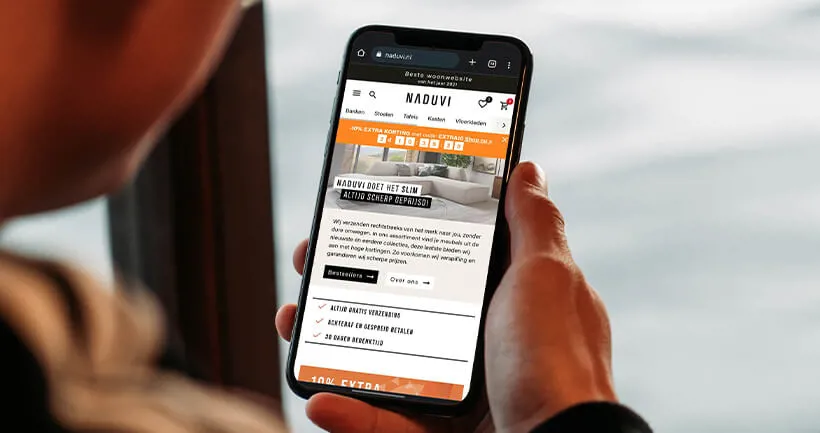Helping Naduvi increase customer conversions by 16%
Reducing the build time from several hours to 17 minutes. Writing custom code. Measuring conversions through A/B testing. Naduvi hired us to help them build a highly customizable bilingual eCommerce website.

Naduvi is a renowned home decor eCommerce website and marketplace. Their greatest competitive advantage lies in the fact that they directly collaborate with recognized interior brands. That enables them to significantly shorten the traditional distribution chain, making sure consumers get the desired products faster.
The challenge: website customization that improves performance
The Naduvi website was built on Shopify, using the Shopify theme and application. The client wanted us to build a highly customizable website – one they could modify and update independently. Their primary goal was to become more flexible in adjusting custom user flows and journeys, and improve performance.
The team - three people for driving eCommerce success
The team consisted of three people - three software engineers, one of whom was a Team Lead.
Boasting strong domain experience, we already knew what practices worked the best in the conversion-driven online retail sector. Best yet, we understood the greatest challenges the businesses in the industry require.
From the website’s functionality to the overall visual appearance, we contributed to the project on multiple levels. Our deep understanding of multilingual websites helped us deliver a highly customizable solution that meets their requirements.
The results: a major boost in conversions
Our innovative ideas, coupled with standardized development processes, contributed to the site’s overall success. Namely, Naduvi’s sales have skyrocketed since we started working on the project. When the new shop was released, the conversion increased by 16%.
How we got those results:
Taking team leadership to a whole new level
Apart from providing innovative website development solutions, we contributed to their overall success on multiple levels.
For starters, the Vega IT team jumped in as a highly experienced technological partner. By standardizing project processes, we managed to reduce unnecessary delays and distractions. As a result, all parts of the project were delivered on time or even ahead of time.
The Vega IT team was also involved in the client’s hiring process for tech roles. That is how we helped them cherry-pick the right people for each project stage.
Cutting the build time
One of the greatest challenges we faced while using static generators was the number of products that were continuously growing. Consequently, a single production build took approximately four hours. Over time, we optimized the build time. Finally, it took only 17 minutes.
Writing a custom code
We used Gatsby, React, and CSS Modules for website development. Gatsby is a static website generator, meaning it generates pages during the build process. That means that all the necessary Contentful content needed to be prepared at the build time. We chose to write a custom code to generate all the GraphQL types that were used. That enabled us to safeguard production builds, even in cases when some content elements were missing.
A/B testing for measuring website conversions
Additionally, we focused on assessing conversions through A/B testing. Here is how:
- We repositioned product sliders to identify the places that are most likely to get the user to add the product to the shopping cart.
- We used the product roll-up using the Algolia search engine. We decided to display four product variations only. That way, we emphasized other products, as well, and ensured they were added to the shopping cart more frequently.
- We implemented several website design variations to check how each impacts website conversions. The next step was the implementation of the design that drove the highest conversions.
The tech stack
- Shopify Plus for eCommerce
- Gatsby, React, CSS Modules for the website
- Algolia as the search engine
- CMS - We used Contentful to make customization easier and to reduce development time. They preferred it, and we had a lot of experience with it. The most important thing for them was to provide the marketing team with the freedom to prepare campaigns in a few clicks
- Google Optimize for A/B testing



